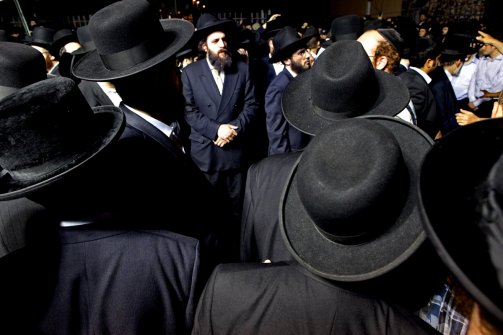From Circumcision to Molestation, How the Ultra-orthodox Place Children at Risk
Daily Beast
A thread running through the stories like this is that even those government officials sworn to protect can be co-opted by the stubborn and unmoving nature of the insular community, or swayed by the large and unified bloc vote its leaders—the same ones who want parents of molested children to come to them first, rather than the police—command. A new audience was exposed to this impasse last week, when The New York Times ran two front-page stories on molestation, which revealed that Orthodox Jews who report such crimes to law enforcement are shunned, and that the Brooklyn district attorney gives rabbis undue influence in determining the best course of action for handling allegations. Despite the uproar, Agudath Israel, a powerful ultra-Orthodox organization, has continued to warn Jews against reporting allegations to the police unless a rabbi has authorized it. For many, the ultra-Orthodox represent a throwback to a simpler time: before television and the Internet took over our lives, and back when you knew most of the people you'd see walking down the street. A lot of that is true, and part of what makes the community seem attractive even to many outsiders, like Oprah Winfrey. But that simplicity comes in part by rejecting many of the innovations of recent decades: new research on infectious and congenital diseases; revisions to building codes; better community policing and fire response; increased attention to sexuality and mental disease; and public-safety-awareness campaigns to educate children and parents that the ultra-Orthodox have avoided along with television sets and unkosher food. Hasidic rabbis and leaders effectively threatened to keep parents from taking sick infants to city hospitals if the health department interfered with a circumcision practice. To maintain their sense of spiritual purity, the ultra-Orthodox community avoids almost all cultural influences from other groups, and eschews many institutions of the state and the broader civil society. But in avoiding what they assert are spiritual dangers from outside, they fail to turn attention to the harm that can be wrought by insiders, which leaders have been reluctant to admit. And where governmental authorities could provide a degree of safety to most other communities, the rabbis who lead those groups rebuff outside threats to their authority with a combination of bloc voting, protests, riots, and other tactics. The dangers to children created by the ultra-Orthodox community’s distrust of non-Jews and their institutions again loomed large in the tragic murder of Leiby Kletzky in Brooklyn last summer. The 8-year old was kidnapped, killed, and dismembered after he got lost trying to make the walk home from summer camp on his own for the first time. The man found with Kletzky's body parts in his refrigerator and trash can was another Orthodox Jew, Levi Aron. As the search for the boy and then the investigation into his murder progressed, we learned that Aron had previously tried to abduct children by offering them rides in his car—even being so bold as to do so in their family driveways—but that while parents chased this attempted kidnapper from their homes, they never notified the police. Worse, police weren’t called in to find the missing boy for hours after he disappeared. Instead, the Shomrim, or ultra-Orthodox volunteer neighborhood-watch groups, wasted crucial time trying to do the job themselves before letting the cops in on the search. If Kletzky, like almost every ultra-Orthodox person, was raised to avoid talking to non-Jews, and to find a fellow Orthodox Jew if he thinks he's in danger, that training may have kept him from recognizing the safe options that existed along his attempted walk home to call his parents or seek assistance. The community’s self-imposed isolation, and the dangers it creates, extends beyond dramatic episodes of criminal activity or unusual rituals into more mundane affairs, like the traffic laws that are routinely flouted in the ultra-Orthodox community—so much so that a 2006 riot started over a ticket for double-parking. Ordinary regulations are often seen within the community as a tool for cops to act out anti-Semitic fantasies. One individual who regularly drives around the entirety of New York City for business told me that on rainy days, it is only in ultra-Orthodox areas that one routinely finds drivers failing to adhere to a decades-old law requiring headlights to be on whenever windshield wipers are. The community also forbids popular media, and their insider-produced media don't come to the attention of those placing PSAs about things like looking both ways before crossing the street. In the ultra-Orthodox enclave of New Square, at least four children have died after being struck by a moving vehicle in just the past two years, which appears to be off the charts in terms of fatalities per vehicle mile traveled there. Then there's basic fire safety. Also in New Square, the community disregards building codes to such a degree that an outgoing fire chief declared:"It's only a matter of time before someone gets killed." The situation is so bad that the local fire department in 2007 asked to have New Square removed from its fire district to avoid being responsible for the ultra-Orthodox failings in fire safety. After more than a decade of reporting on issues of sexual and violent abuse, abuse of rabbinic authority, and harm coming to children, it's clear that there's no direct way to stop these problems, and that no Jewish media outlet has the resources to report this. We're all better served when the law is applied equally to everyone, and when criminals and safety hazards are removed from our midst. But when first rabbis and then law enforcement fail to meet their responsibility to protect and help those who are in need, that means the Jewish community has no greater savior than The New York Times.
|
.
Any original material on these pages is copyright © BishopAccountability.org 2004. Reproduce freely with attribution.
